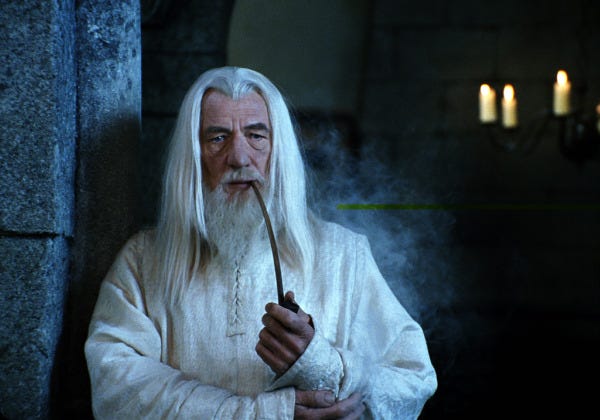Heroes of the Zeroes: The Lord of the Rings (2001-03)
Heroes of the Zeroes is a daily, alphabetical look back at the 365 best films of 2000-2009. Today's entry counts as three films.
"The Fellowship of the Ring" / "The Two Towers" / "The Return of the King" Rated PG-13 2001 / 2002 / 2003
Like Hobbit protagonist Frodo Baggins wearing the hefty One Ring around his neck on a quest to destroy it, Peter Jackson no doubt struggled with the weight of fanboy expectations.
Lesser directors would’ve caved under the hype and anticipation surrounding his ambitious adaptation of J.R.R. Tolkien’s legendary Middle-earth saga.
Yet, over the course of three films in 2001, 2002 and 2003 and 10-plus hours — longer on the richer, fuller DVD director’s cuts — Jackson delivered soaring, searing tales of wonderment with electric, genre fence-jumping moves that rank these films among the all-time greats.
An unflagging charge from the introductory first frame to the welcome-home last, “The Lord of the Rings” is powered by burnished, literary masterstrokes of heroism, courage, friendship, betrayal, love, resolve and anger. Where Jackson could have fallen from a precipice, he instead presented a cumulatively career-defining work of greatness.
The worlds of men, dwarves, elves and Hobbits (furry short folk) are threatened by the reemergence of the One Ring — sought by the evil lord Sauron who would use it to overrun the land with creatures from the bowels of the world.
In “The Fellowship of the Ring,” a small group is entrusted to journey across Middle-Earth and destroy the ring by tossing it into the fires of Mount Doom — easier said than done.
“The Fellowship of the Ring” bears well the burden of exposition and character introduction, and also introduces two of the series’ numerous action setpieces, both set in the dank Mines of Moria. Battles against a cave troll and the viciously inflammatory Balrog aren’t just visual-effects reels, but trials by fire of the camaraderie among this band of brothers.
“The Two Towers” — tracking the group as it has been severed and scattered — balances a rainy, prolonged battle for Helm’s Deep (a crucial outpost) with Frodo (Elijah Wood) and friend Samwise’s (Sean Astin) struggle for possession of the One Ring with the duplicitous Gollum.
Driven to madness by the ring’s powers, what was once known as Smeagol transformed into the amphibious, murderous Gollum. Andy Serkis’s work in creating Gollum — he acted alongside Wood and Astin, with movements fed into a computer to animate the character — deserved an honorary Academy Award. His gestures and voice, not computer software, made Gollum so memorable as he wrestled with his inner homicidal maniac.
Avoiding the ineffective conclusion jinx, “The Return of the King” set so many standards in its overwhelming epic wash that future attempts only seemed like pretenders to the throne. Even “Avatar,” as visionary as it could be, owed a debt to Jackson’s scope here.
Every location, whether real or digitally enhanced, is a jaw-dropping dazzler. Minas Tirith resembles a fort as drawn by M.C. Escher, and its evil counterpart, Minas Morgul, looks like a demented Sydney Opera House lit by Kryptonite.
It also allows supporting performers room for affecting arcs — Billy Boyd and Dominic Monaghan’s Pippin and Merry grow from curious troublemakers to noble warriors who understand the consequences of their choices. Plus, Astin delivers a performance of gale-force emotions, watching his lifelong friend teeter on the edge of madness and death.
Its centerpiece — the rousing defense of Minas Tirith — is all it was billed to be, the battle to end all battles. Jackson takes us to the battlefield’s blades of grass with meticulous detail amid all the chaos. You feel the swath cut by charging, woolly mammoth-type beasts and the swift dive-bomb attacks of Sauron’s flying minions.
“The Return of the King’s” patient conclusion became a pop-culture punchline, but it certainly earns this extended epilogue. After hours spent with so many richly drawn characters — not just Frodo, Samwise, Pippin, Merry and Gollum, but Ian McKellen’s compassionate wizard Gandalf, Viggo Mortensen’s swashbuckling rogue Aragorn and John Rhys-Davies’ Gimli, a fearless dwarf who learns tolerance in wartime — why wouldn’t Jackson strive to give each one a fitting, emotional sendoff?
Although New Line, the trilogy’s financing studio, wound up folding after wasting its “Rings” profit on a passel of expensive projects, Jackson plans to return to Middle-Earth this decade. He’s producing (and now possibly directing) a two-part prequel with “The Hobbit,” to be released annually a la “Rings.”
Prequels often run the risk of dramatic pointlessness — sucking out any danger and unpredictability that surrounds characters whose fates you already know. (See “X-Men Origins: Wolverine.”) But if anyone is up to bucking that challenge, it’s Jackson, emboldened by authorship of what was, arguably, the only trilogy in cinematic history that didn’t fall victim to excess, bloat or disinterest.



